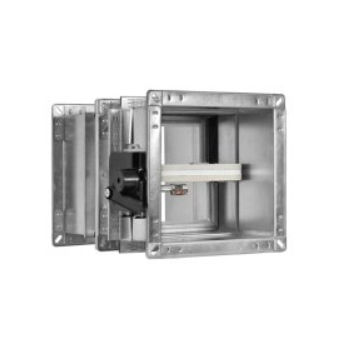
Fire damper WK43 SERIES
Add to favorites
Compare this product
Description
Overview
Fire dampers Series WK43 ensure maximum safety in the prevention of the spread of fires within the buildings. Indeed they guarantee the perfect heat insulation and complete seal is to hot to cold smoke fumes as demonstrated by the numerous tests performed according to standard EN 1366-2.
Fire dampers are a series WK43 insurmountable barrier to the spread of fire, the heat transfer and spread of noxious fumes and gases through the seal tested for depression 300Pa as foreseen by EN 1366-2 standard. By connecting the dampers to the fire alarm system and smoke detectors can anticipate the closing of the blade compared to the direct action of the flame and thus preventing the onset of indirect damage arising from the spread of smoke and gases generated by combustion.
Technical data
Sizes from 200x200mm to 1500x800mm
More size realized by coupling two damper flange to flange (for mounting in rigid walls)
Classified for installation:
within the walls filled with concrete or cellular concrete or masonry 100 mm minimum thickness 500 Kg/m³ minimum density class EI 120 (ve i↔o) S ;
within the walls filled with concrete or cellular concrete or masonry 140 mm minimum thickness 500 Kg/m³ minimum density class EI 180 (ve i↔o) S ;
coupled battery “flange to flange” within solid walls of concrete or cellular concrete or masonry 100 mm minimum thickness 500 Kg/m³ minimum density class EI 120 (ve i↔o) S;
within concrete floors 140 mm minimum thickness 2200 Kg/m³ minimum density class EI 180 (ho i↔o) S;
within concrete floors 150 mm minimum thickness 650 Kg/m³ minimum density class EI 120 (ho i↔o) S;
Catalogs
No catalogs are available for this product.
See all of MP3‘s catalogsRelated Searches
- Air grating
- Metal exhaust fan
- Metal ventilation grill
- Commercial exhaust fan
- Rectangular air grating
- Indoor exhaust fan
- Mechanical ventilation unit
- Extractor exhaust fan
- Residential exhaust fan
- Duct exhaust fan
- Displacement air diffuser
- Plastic exhaust fan
- Aluminium ventilation grill
- Air curtain
- Square ventilation grill
- Commercial air curtain
- Axial exhaust fan
- Ceiling displacement air diffuser
- White ventilation grill
- Centrifugal exhaust fan
*Prices are pre-tax. They exclude delivery charges and customs duties and do not include additional charges for installation or activation options. Prices are indicative only and may vary by country, with changes to the cost of raw materials and exchange rates.














